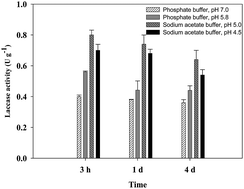Removal of organic toxic chemicals using the spent mushroom compost of Ganoderma lucidum
Abstract
The removal of the organic toxic chemicals di-n-butyl phthalate (DBP), di-2-ethyl hexyl phthalate (DEHP), nonylphenol (NP), and bisphenol-A (BPA) by laccase obtained from the spent mushroom compost (SMC) of the white rot fungi, Ganoderma lucidum, was investigated. The optimal conditions for the extraction of laccase from SMC required using sodium acetate buffer (pH 5.0, solid : solution ratio 1 : 5), and extraction over 3 h at 4 °C. The removal of NP was enhanced by adding CuSO4 (1 mM), MnSO4 (0.5 mM), tartaric acid (20 mM), 2,2′-azino-bis-(3-ethylbenzothiazoline-6-sulfonic acid) (ABTS; 1 mM), and 1-hydroxybenzotriazole (HBT; 20 mg L−1), with ABTS yielding a higher NP removal efficiency than the other additives. At a concentration of 2 mg L−1, DBP, DEHP, NP, and BPA were almost entirely removed by laccase after incubation for 1 day. The removal efficiencies, in descending order of magnitude, were DBP > BPA > NP > DEHP. We believe that these findings could provide useful information for improving the efficiency of the removal of organic toxic chemicals in the environment.


 Please wait while we load your content...
Please wait while we load your content...